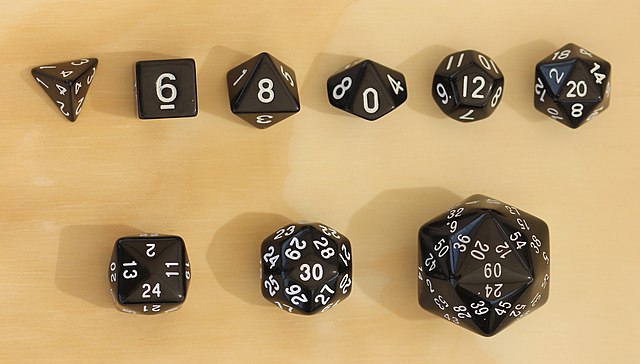Dice Roller Calculator
Welcome to the Omni dice roller calculator! The perfect tool for when you can't find the right number of dice for your favorite board game. It supports up to 15 dice and 20 different types of dice, including all the ones used in Dungeon and Dragons, so, don't worry, you can use it as a DND dice roller. Are you feeling lucky? Let's roll some dice!
If you want to calculate the probability of a particular result when throwing dice, check out our dice probability calculator.
This random dice roller calculator supports twenty types of dice

You're probably very familiar with the standard form of dice, which is the shape of a cube, with its dots such that every opposite face adds up to seven. Of course, we use other three-dimensional shapes as dice so that you can generate more or fewer numbers with each throw. This dice roller calculator supports an amazing 20 different dice shapes. Let's explore them.
- 3-sided dice — a rounded-off triangular prism. This die is long, and you throw lengthwise.
- 4-sided dice — a tetrahedron. Each face is an equilateral triangle.
- 5-sided dice — a triangular prism. The prism is thin so that it can either land on both a face or an edge.
- 6-sided dice — a cube. The classic die where each face is a square.
- 7-sided dice — a pentagonal prism. Used in the seven-player version of backgammon.
- 8-sided dice — a octahedron. Each face is an equilateral triangle and looks like two square pyramids attached at their bases. The sum of opposite faces is usually 9.
- 10-sided dice — a pentagonal trapezohedron. Each face is a kite shape.
- 12-sided dice — a dodecahedron. Each face is a regular pentagon. The sum of opposite faces is normally 13.
- 14-sided dice — a heptagonal trapezohedron. Each face is a kite shape.
- 16-sided dice — a octagonal bipyramid. Each face is an isosceles triangle.
- 18-sided dice — a rounded rhombicuboctahedron. The sides with numbers are squares, and eight faces are triangles, on which you can not land.
- 20-sided dice — an icosahedron. Each face is an equilateral triangle, and opposite faces add up to 21.
- 24-sided dice — various shapes, including triakis octahedron (isosceles triangle faces), tetrakis hexahedron (isosceles triangle faces), deltoidal icositetrahedron (kite faces), and pentagonal icositetrahedron (irregular pentagon faces).
- 30-sided dice — a rhombic triacontahedron. Each face is a rhombus.
- 34-sided dice — a heptadecagonal trapezohedron. Each face is a kite.
- 48-sided dice — a disdyakis dodecahedron. Each face is a scalene triangle.
- 50-sided dice — an icosikaipentagonal trapezohedron. Each face is a kite.
- 60-sided dice — various shapes, including deltoidal hexecontahedron (kite faces), the pentakis dodecahedron (isosceles triangle faces), pentagonal hexecontahedron (irregular pentagon faces), and triakis icosahedron (isosceles triangle faces.
- 100-sided dice — a zocchihedron. A sphere within a sphere with 100 numbered flattened faces. Physically, it is not a fair die, as some numbers are more likely than others. That's not the case with the Omni dice roller, which is fair.
- 120-sided dice — a disdyakis triacontahedron. Each face is a scalene triangle.
How to use this online dice roller calculator
To use this dice roller:
- Select the number of dice you want to throw, any number from one to 15.
- Select the type (number of sides) of each dice. The default is the conventional six-sided die. For example, select "Icosahedron (20 faces)" to make a d20 dice roller.
- If you want to throw more than one die and they are all the same shape, use the "Set all dice types to" option to set the type of all the dice. If you want to roll different dice types together, select the last dropdown option for the "Set all dice types" selection and choose the dice type for each dice.
- Go to the bottom of the dice roller and tick the "Roll" checkbox to roll the dice. To roll the dice again, simply untick the "Roll" checkbox. Every tick and untick of the "Roll" checkbox rolls the dice. Happy rolling!
- The dice roller calculator shows you the sum of the values of the rolled dice at the bottom. Underneath the total, the calculator shows the result of each die.
If you're using it as a DND player, you might also want to check the point buy calculator 5e, too!